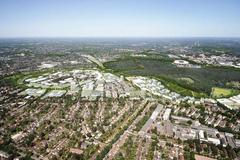Virtual view of Science City Bahrenfeld in 2040. Credit: Spengler Wiescholek Architekten Stadtplaner, WES GmbH Landschaftsarchitekten, Urban Catalyst GmbH; Visualisation: Moka-studio [Source]
The Hamburg Senate, the Altona district, DESY and the University of Hamburg today presented the plans for a science district in western Hamburg at a press conference. In the "Science City Bahrenfeld", science, business and housing are to be closely interlinked in the development of a new district. The Science City Bahrenfeld is being built on an area of 125 hectares around the research campus in Bahrenfeld and includes new scientific institutes and facilities as well as around 2500 apartments. In addition to DESY's expansion, the plans enable the University of Hamburg to locate even more of its institutes in the Science City. As a "green heart", the Altonaer Volkspark will combine science and research with living and recreation quality, sports and health areas. The Science City Bahrenfeld will also become an attractive place to live due to its connection to local rail transport, innovative transport concepts and the expansion of attractive recreational and leisure areas. The first architectural competitions for the new science district are planned for 2020.
Mayor Peter Tschentscher says: "Together with the university and DESY, we want to dedicate an entire city district to science in the coming years. With Science City Bahrenfeld, we are developing a centre for basic research and applied science, an incubator for innovation and technology transfer. At the same time, attractive apartments and recreational areas for students, scientists and creative people are to be created in the quarter. These are all ideal conditions for scientific institutions, start-ups and innovative companies, with laboratories and modern workplaces for bright minds from all over the world."
"DESY strongly supports the plans for Science City Bahrenfeld. We are creating a model for the research campus of the future, in which cutting-edge research with state-of-the-art large-scale research facilities, the training of young scientists and the transfer to industry and society - closely interlinked - are consistently implemented as sustainable concepts," says Prof. Helmut Dosch, Chairman of the DESY Board of Directors.
Katharina Fegebank, Senator for Science, Research and Equality, says: "It is impressive how everyone is working together to make Science City Bahrenfeld possible. For the first time in the history of Hamburg, science and research are playing the leading role in the development of a city quarter. We expect this to lead to even more scientific excellence, innovation, quality of life and jobs for Hamburg's future."
In Science City Bahrenfeld, science is becoming the engine of urban development: the ultra-modern and internationally networked science campus is to be further expanded. The Centre for Data and Computer Science (CDCS), the Centre for Molecular Water Research (CMWS) and DESY's planned 3D X-ray microscope PETRA IV "Next Generation" are key pillars of Science City, as is the permanent establishment of the physics, chemistry and biology departments of the university. This scientific expansion will be combined with "Living at the Volkspark" in the "Vision for the Future 2040" presented on Tuesday. The concept of Science City Bahrenfeld is to be the beginning of a process to be further developed over the coming years and decades.
"The Science City in Bahrenfeld will be an important urban development project for Hamburg," explains Dr. Dorothee Stapelfeldt, Senator for Urban Development and Housing. "Here, a new urban space is being developed in which a modern, mixed-use quarter with 2500 apartments is added to the existing residential development. An urban space in which excellent scientific facilities will be expanded and interwoven with the urban infrastructure directly adjacent to Hamburg's largest parks. Housing, science and innovative business form the core of an urban development that is unique for Hamburg."
In the Altona Innovation Park and in an innovation centre on the DESY campus, start-ups and innovative companies are to research new technologies together with science.
The concept of Science City Bahrenfeld with its vision of the future 2040 is a clear prelude to the integration of research, science and teaching into the new and existing district structures of Bahrenfeld. It was developed jointly by the scientific and economic authorities, the environment and energy authority, the urban development and housing authority, the Altona district office, DESY and the University of Hamburg.









